About Elliott Waves Theory Basics
The Elliott Wave Theory is named after Ralph Nelson Elliott. Inspired by the Dow Theory and by observations found throughout nature, Elliott concluded that the movement of the stock market could be predicted by observing and identifying a repetitive pattern of waves. In fact, Elliott believed that all of man's activities, not just the stock market, were influenced by these identifiable series of waves.
Elliott based part his work on the Dow Theory, which also defines price movement in terms of waves, but Elliott discovered the fractal nature of market action. Thus Elliott was able to analyze markets in greater depth, identifying the specific characteristics of wave patterns and making detailed market predictions based on the patterns he had identified.
Definition of Elliott Waves
In the 1930s, Ralph Nelson Elliott found that the markets exhibited certain repeated patterns. His primary research was with stock market data for the Dow Jones Industrial Average. This research identified patterns or waves that recur in the markets. Very simply, in the direction of the trend, expect five waves. Any corrections against the trend are in three waves. Three wave corrections are lettered as "a, b, c." These patterns can be seen in long-term as well as in short-term charts. Ideally, smaller patterns can be identified within bigger patterns. In this sense, Elliott Waves are like a piece of broccoli, where the smaller piece, if broken off from the bigger piece, does, in fact, look like the big piece. This information (about smaller patterns fitting into bigger patterns), coupled with the Fibonacci relationships between the waves, offers the trader a level of anticipation and/or prediction when searching for and identifying trading opportunities with solid reward/risk ratios.
There have been many theories about the origin and the meaning of the patterns that Elliott discovered, including human behavior and harmony in nature. These rules, though, as applied to technical analysis of the markets (stocks, commodities, futures, etc.), can be very useful regardless of their meaning and origin.
Simplifying Elliott Wave Analysis
Elliott Wave analysis is a collection of complex techniques. Approximately 60 percent of these techniques are clear and easy to use. The other 40 are difficult to identify, especially for the beginner. The practical and conservative approach is to use the 60 percent that are clear.
When the analysis is not clear, why not find another market conforming to an Elliott Wave pattern that is easier to identify?
From years of fighting this battle, we have come up with the following practical approach to using Elliott Wave principles in trading.
The whole theory of Elliott Wave can be classified into two parts:
Impulse patterns
Corrective patterns
Impulse Patterns
The impulse pattern consists of five waves. The five waves can be in either direction, up or down. Some examples are shown to the right and below.The first wave is usually a weak rally with only a small percentage of the traders participating. Once Wave 1 is over, they sell the market on Wave 2. The sell-off in Wave 2 is very vicious. Wave 2 will finally end without making new lows and the market will start to turn around for another rally.
ELLIOTT WAVES
_________________________________________________________
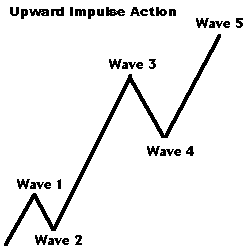
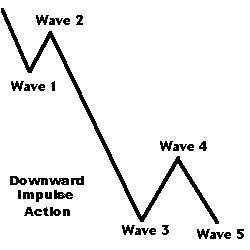
The initial stages of the Wave 3 rally are slow, and it finally makes it to the top of the previous rally (the top of Wave 1).
At this time, there are a lot of stops above the top of Wave 1.
Traders are not convinced of the upward trend and are using this rally to add more shorts. For their analysis to be correct, the market should not take the top of the previous rally.
Therefore, many stops are placed above the top of Wave 1.
The Wave 3 rally picks up steam and takes the top of Wave 1. As soon as the Wave 1 high is exceeded, the stops are taken out. Depending on the number of stops, gaps are left open. Gaps are a good indication of a Wave 3 in progress. After taking the stops out, the Wave 3 rally has caught the attention of traders
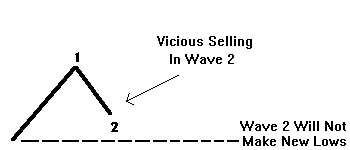
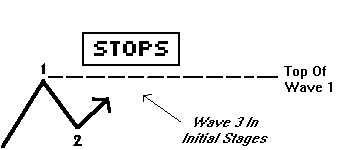
The next sequence of events are as follows: Traders who were initially long from the bottom finally have something to cheer about. They might even decide to add positions.
The traders who were stopped out (after being upset for a while) decide the trend is up, and they decide to buy into the rally. All this sudden interest fuels the Wave 3 rally.
This is the time when the majority of the traders have decided that the trend is up.
Finally, all the buying frenzy dies down; Wave 3 comes to a halt.
Profit taking now begins to set in. Traders who were long from the lows decide to take profits. They have a good trade and start to protect profits.This causes a pullback in the prices that is called Wave 4.
Wave 2 was a vicious sell-off; Wave 4 is an orderly profit-taking decline.
While profit-taking is in progress, the majority of traders are still convinced the trend is up. They were either late in getting in on this rally, or they have been on the sideline.
They consider this profit-taking decline an excellent place to buy in and get even.
On the end of Wave 4, more buying sets in and the prices start to rally again.
The Wave 5 rally lacks the huge enthusiasm and strength found in the Wave 3 rally. The Wave 5 advance is caused by a small group of traders.
Although the prices make a new high above the top of Wave 3, the rate of power, or strength, inside the Wave 5 advance is very small when compared to the Wave 3 advance.
Finally, when this lackluster buying interest dies out, the market tops out and enters a new phase.
Corrective Patterns
Corrections are very hard to master. Most Elliott traders make money during an impulse pattern and then lose it back during the corrective phase.
An impulse pattern consists of five waves. With the exception of the triangle, corrective patterns consist of 3 waves. An impulse pattern is always followed by a corrective pattern. Corrective patterns can be grouped into two different categories:
Simple Correction (Zig-Zag)
Complex Corrections (Flat, Irregular, Triangle)
Simple Correction (Zig-Zag)
There is only one pattern in a simple correction. This pattern is called a Zig-Zag correction. A Zig-Zag correction is a three-wave pattern where the Wave B does not retrace more than 75 percent of Wave A. Wave C will make new lows below the end of Wave A. The Wave A of a Zig-Zag correction always has a five-wave pattern. In the other two types of corrections (Flat and Irregular), Wave A has a three-wave pattern. Thus, if you can identify a five-wave pattern inside Wave A of any correction, you can then expect the correction to turn out as a Zig-Zag formation.
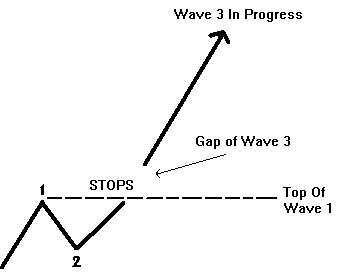
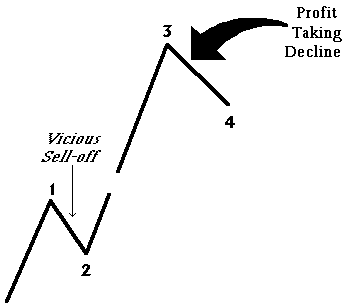
Complex Corrections (Flat, Irregular, Triangle)
The complex correction group consists of 3 patterns:
• Flat
• Irregular
• Triangle
Flat Correction
In a Flat correction, the length of each wave is identical. After a five-wave impulse pattern, the market drops in Wave A. It then rallies in a Wave B to the previous high. Finally, the market drops one last time in Wave C to the previous Wave A low.
Triangle Correction
In addition to the three-wave correction patterns, there is another pattern that appears time and time again. It is called the Triangle pattern. Unlike other triangle studies, the Elliott Wave Triangle approach designates five sub-waves of a triangle as A, B, C, D and E in sequence.
Fibonacci Ratios in an Irregular Wave
Wave B = either 1.15 x
Wave A or 1.25 x Wave A
Wave C = either 1.62 x
Wave A or 2.62 x Wave A
Irregular Correction
In this type of correction, Wave B makes a new high. The final Wave C may drop to the beginning of Wave A, or below it.
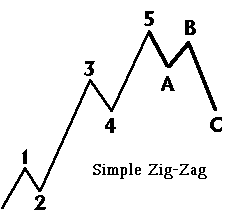
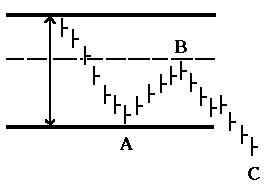
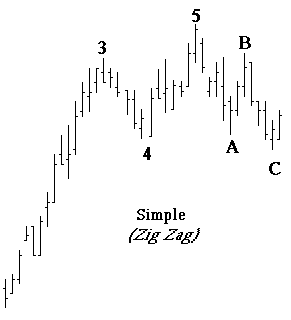
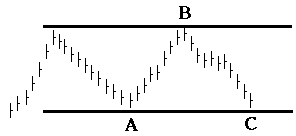
Fibonacci Ratios inside a Zig-Zag Correction
Wave B
Usually 50% of Wave A
Should not exceed 75% of Wave A
Wave C
either 1 x Wave A
or 1.62 x Wave A
or 2.62 x Wave A
A simple correction is commonly called a Zig-Zag correction.
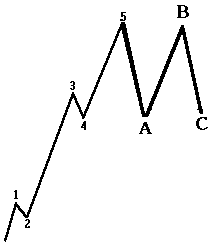
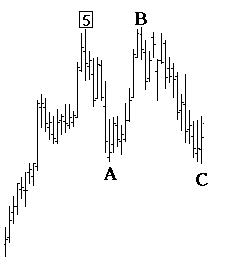
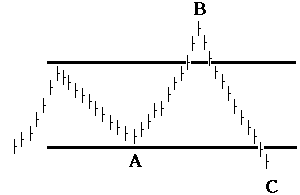
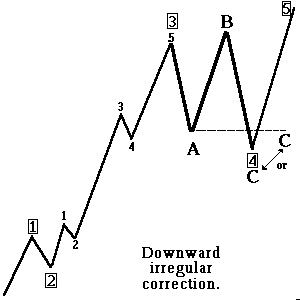
Triangles, by far, most commonly occur as fourth waves. One can sometimes see a triangle as the Wave B of a three-wave correction. Triangles are very tricky and confusing. One must study the pattern very carefully prior to taking action. Prices tend to shoot out of the triangle formation in a swift thrust.
When triangles occur in the fourth wave, the market thrusts out of the triangle in the same direction as Wave 3. When triangles occur in Wave Bs, the market thrusts out of the triangle in the same direction as the Wave A.
Alteration Rule
If Wave Two is a simple correction, expect Wave Four to be a complex correction.
If Wave Two is a complex correction, expect Wave Four to be a simple correction.
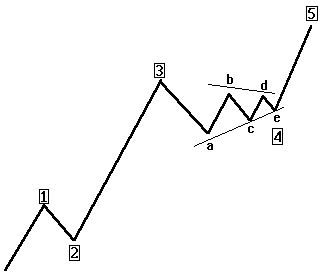
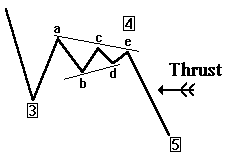
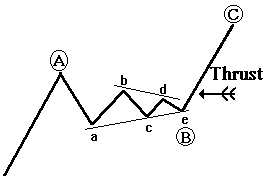
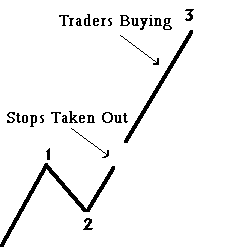
eBooks about ELLIOTT WAVES THEORY
- Elliott Wave Basic Tutorial
- Elliott Wave Advanced Tutorial
- Glenn Neely-Master Elliott Wave (low quality)
- Prechter_ Robert - The Major Works Of R N Elliott (low quality)
- Prechter, Robert - The Complete Elliott Wave Writings of Hamilton Bolton (DJVU) (low quality)
- Robert Balan - Elliott Wave Principle (DJVU) (low quality)
- Walker, Myles Wilson - How To Indentify High-Profit Elliott Wave Trades in Real Time
Annual Elliott Wave Analysis for 2009
Related Topics
----------- EDUCATION ---------
-------TRADING METHODS ------
--------- FOR TRADERS ---------
-------------- OTHER ------------

_________________________________________________________________________________________________________________________________________
Do you like fx1618?
If you think fx1618.com is cool and want to help fx1618, please tell your friends about it via email and blog (or forum)
